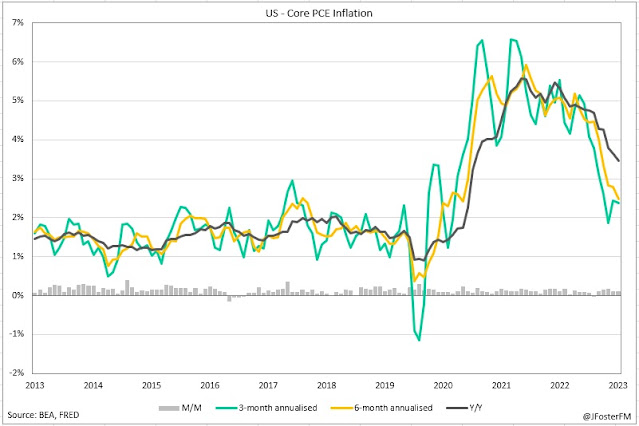A broad-based rally across markets closed out a memorable November. US equities lifted between 8-11% and Europe by around 8%, coming alongside substantial declines in Treasury yields, at both ends of the curve. This backdrop has kept the Australian dollar supported at 3-month highs. Falling inflation has buoyed optimism for significant rate-cutting cycles in 2024 on the view that central banks will look to normalise monetary policy from the restrictive settings that prevail in many countries presently.
In the US, comments from Fed Governor Waller indicating that falling inflation opened the door to lower rates resonated strongly in markets. Later in the week, Fed Chair Powell offered some pushback by saying it was premature to conclude that rates had peaked, let alone to speculate on the timing of rate cuts. These assessments appear to reflect the core view of FOMC members, though Chair Powell did concede that rates were "well into restrictive territory", seemingly making additional tightening less likely. The inflation data back this up, with the core PCE deflator slowing from 3.7% to 3.5% at an annual rate in October, a low to April 2021. But in 3-month (2.4%) and 6-month (2.5%) annualised terms, the recent momentum suggests core inflation is on track to be within touching distance of the Fed's 2% target.
There were several public appearances by top ECB officials this week but downside surprises in November's inflation data spoke loudest of all. Headline inflation declined from 2.9% to 2.4%yr (vs 2.7% expected) - a low to August 2021 - while the core rate came in from 4.2% to 3.6% (vs 3.9%), a 19-month low. These outturns imply inflation is declining on a faster trajectory than currently forecast by the ECB, leading markets to start pricing in rate cuts as soon as April next year. This expectation is driven not only by disinflationary momentum but also by weakness in economic activity. Euro area GDP contracted marginally in Q3 (-0.1%) and recent PMI readings have been consistent with declining output continuing.
Despite its hawkish messaging of late, including from Governor Bullock in Hong Kong this week, the chances of the RBA hiking at next week's meeting have always looked remote. But whatever chance there was of a December rate hike dissipated following this week's data. Headline inflation surprised on the downside falling from 5.6% to 4.9% in October (vs 5.2% exp), with the measures of underlying inflation also softening but sitting in a more elevated range of 5-5.3% (full review here). Meanwhile, retail sales posted their weakest outturn in four months falling 0.2% in October as spending was delayed ahead of Black Friday sales (see here).
Aside from the RBA meeting, attention next week will be on the Q3 National Accounts. My detailed preview (see here) sets out what is known about how the Australian economy performed in Q3, with GDP growth of around 0.4%q/q anticipated. Partial indicators received this week that feed into the GDP outcome reported stronger than expected detail for construction activity at 1.3%q/q (see here), but capital expenditure by firms slowed to 0.6%q/q, printing on the soft side of estimates (see here). National housing prices according to CoreLogic remained on the rise - albeit at a slowing pace of 0.6% in November - to be nearly 10% above cycle lows. A housing supply shortfall has largely driven this upswing in prices, outweighing the effects of RBA tightening. However, this has not translated to any material improvement in building approvals, although they posted a welcome 7.5% rise in October (see here).




